El renacimiento de las finanzas descentralizadas: cómo hacer que las finanzas descentralizadas vuelvan a ser grandiosas
Original article by: Arthur Cheong, Eugene Yap
Traducción original: Unicornio en bloque

The European Renaissance, which began in the 14th century, ignited a revival of art, culture, and thought, and completely changed modern civilization.
Today, we are witnessing a similar awakening in crypto – the renaissance of decentralized finance (DeFi). Like the Renaissance in history, this movement is breaking down barriers and reshaping our understanding of money and finance. Powered by blockchain and smart contracts, DeFi democratizes financial services, giving people around the world access to a trustless economy without traditional financial intermediaries. It has the potential to completely reshape finance.
Just as the European Renaissance thrived on technological advancement and social change, the DeFi renaissance is being driven by a few key factors that are helping it move beyond its early challenges and into a whole new phase of growth and innovation.
1. DeFi is emerging from the trough of disillusionment
DeFi experienced a surge in 2020 and 2021, when people had high hopes that it would completely disrupt traditional finance (TradFi). However, like most emerging technologies, early hype led to disappointment as the infrastructure was not yet complete, leading to a downturn in 2022.
However, like any revolutionary movement, DeFi has become more resilient, successfully crossed the Trough of Disillusionment and began to climb the Slope of Enlightenment. The Gartner Hype Cycle is an effective framework that can well illustrate this process, and DeFi is currently showing signs of recovery.
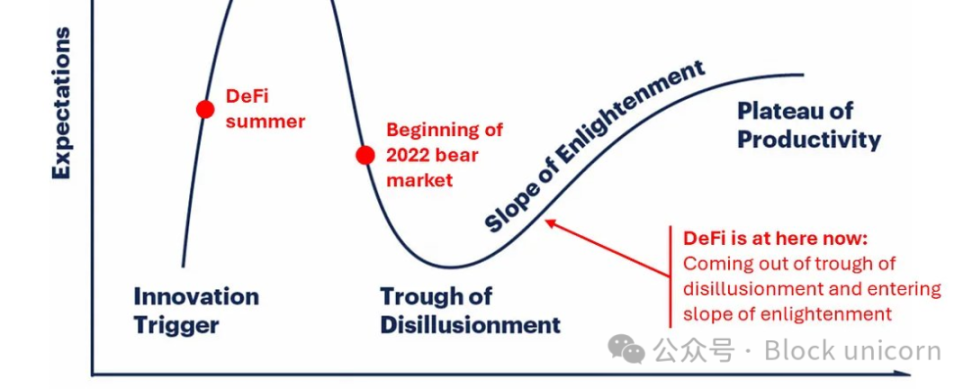
After two years of correction, key indicators such as total locked value (TVL) are rebounding, as shown in the figure below. While some of the improvement in indicators is due to rising crypto asset prices, transaction volume on DeFi platforms has also increased significantly, almost returning to 2022 levels, proving that this recovery is real.
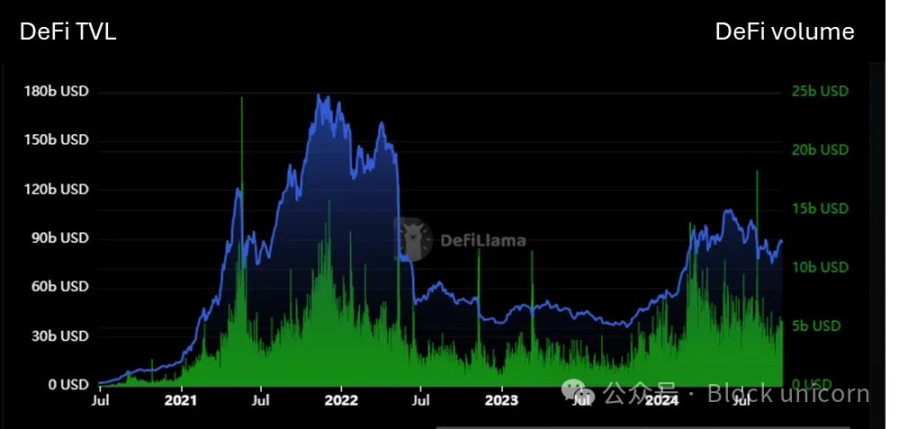
In fact, some foundational DeFi projects, such as Aave, have even surpassed their 2022 peaks in multiple metrics. For example, Aave’s quarterly revenue has surpassed the level of the fourth quarter of 2021 — a period considered the peak of the last bull run.
This suggests that DeFi is maturing, entering a new phase of productivity, and preparing for long-term scalability.
2. The new interest rate cycle will make DeFi returns more attractive
The recovery of DeFi is not only driven by internal factors, but external economic changes have also played a key role. As global interest rates change, high-risk assets such as crypto assets, including DeFi, have become more attractive to investors seeking higher returns.
With the Federal Reserve implementing a 50 basis point rate cut in September, the market is preparing for what could be a period of low interest rates, similar to the environment that fueled the crypto bull runs of 2017 and 2020, as shown in the chart below. Bitcoin (and crypto) bull markets are shown in the green zone and typically occur in low interest rate environments, while bear markets are shown in the red zone and typically occur during periods of surging interest rates.
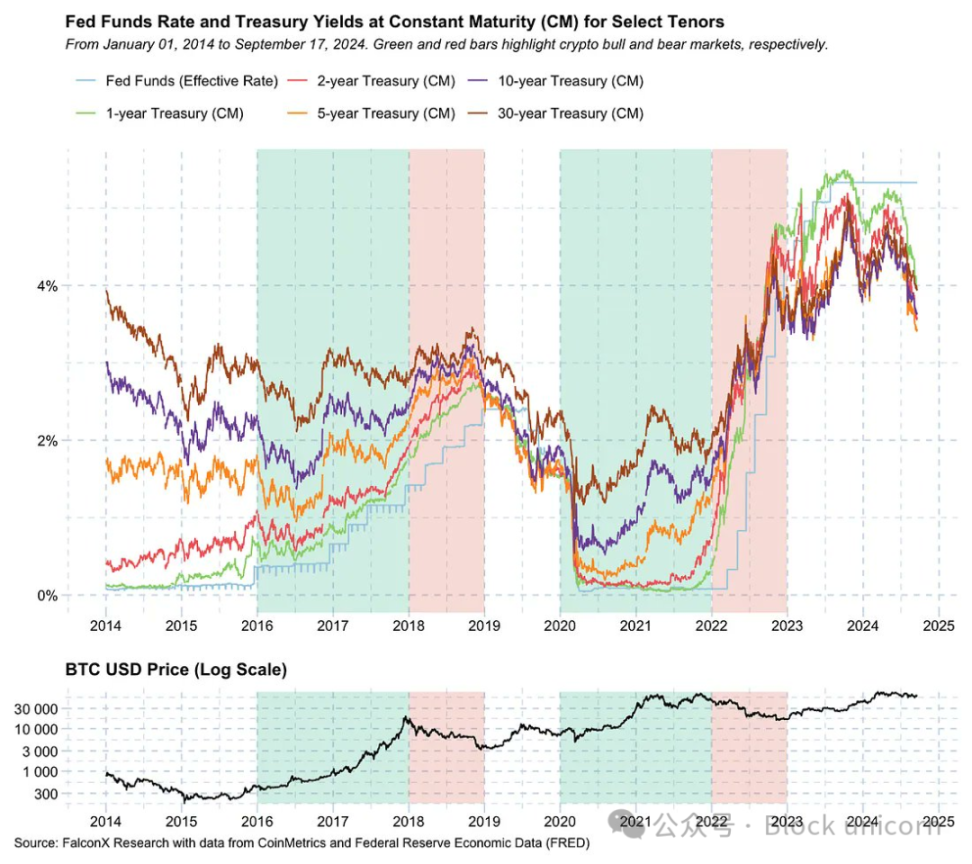
DeFi benefits from a low interest rate environment in two key ways:
1. Lower opportunity cost of capital – As Treasury bonds and traditional savings accounts offer lower returns due to falling interest rates, investors may turn to DeFi protocols to earn higher returns through yield farming, staking, and liquidity provision.
2. Lower loan costs – Financing costs become lower, encouraging DeFi users to borrow and use funds for productive purposes, thereby driving the activity of the entire ecosystem.
While interest rates may not drop to the near-zero levels of past cycles, the opportunity cost of participating in DeFi will be significantly reduced. Even a modest drop in interest rates is enough to have a significant impact because the difference between interest rates and returns can be amplified through leverage.
In addition, we expect the new interest rate cycle to become an important factor in driving the growth of stablecoins, as it greatly reduces the capital cost of traditional financial (TradFi) funds entering DeFi to seek returns. In the previous cycle, the Federal Funds Rate (FFR) had an inverse relationship with the growth of stablecoin supply, as shown in the figure below. As interest rates fall again, the supply of stablecoins is expected to grow, providing more funds for the accelerated development of DeFi.
3. Finance: Cryptocurrency’s Biggest Product-Mercado Fit
The crypto space has tried a variety of application scenarios, such as NFT, metaverse, games, and social networking, etc. However, judging by most objective indicators, they have not really found product-market fit (PMF).
For example, despite a brief recovery in 2024 brought on by Bitcoin Ordinals, daily NFT trading volume continues to decline.
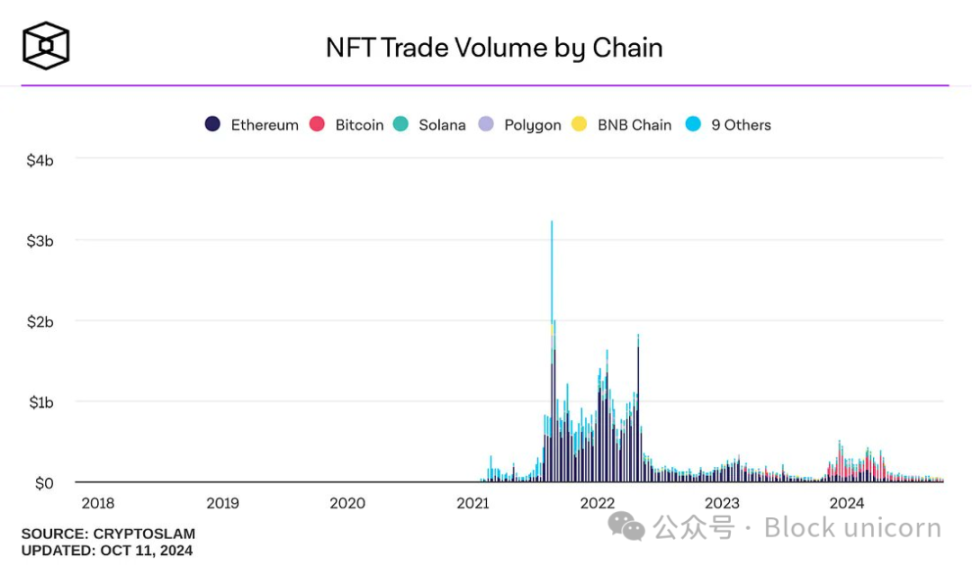
As for the metaverse and games, there are no breakthrough Web3 games that are widely accepted by fans around the world. The two OG-level Web3 metaverse projects, Decentraland and Sandbox, have difficulty breaking through a few thousand daily active users, while Roblox has 80 million daily active users. Although the daily active users of TON games are impressive, it is uncertain how many people will continue to stay on TON games once the economic incentives are gone.
In contrast, DeFi has proven its product-market fit. The growth of core DeFi categories such as liquid staking and lending, which have expanded by more than 100% year-on-year, is a testament to its strong appeal. At the same time, new, multi-billion-dollar categories such as heavy staking (Eigenlayer) and basis trading (Ethena) are emerging, with almost zero total value locked (TVL) a year ago. This explosive growth demonstrates the composability and permissionless nature of DeFi, where new financial Lego can be stacked on top of each other to unlock new use cases.
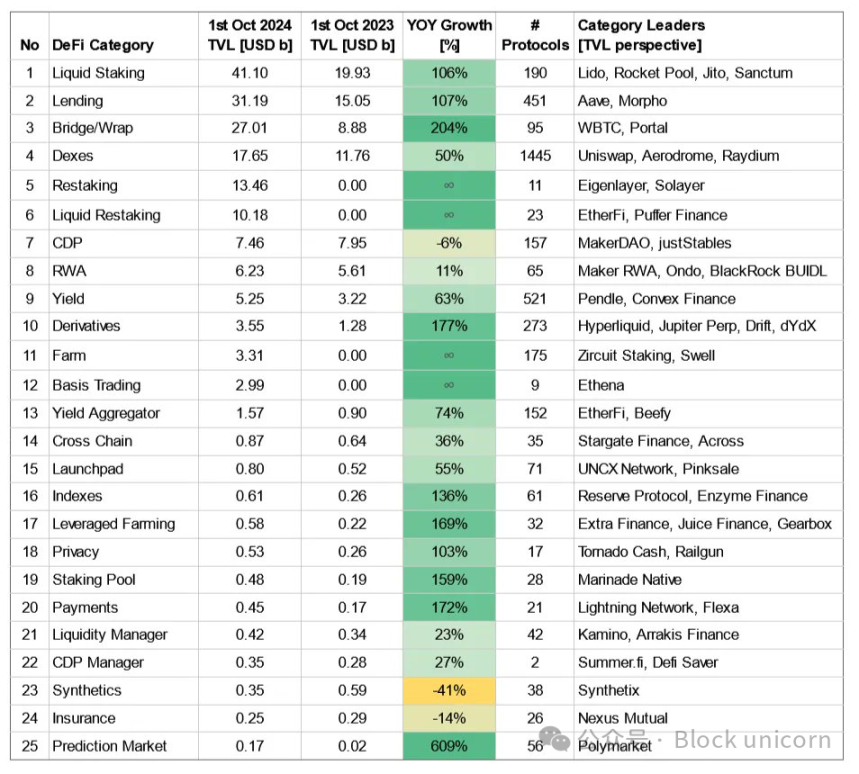
Regulatory barriers have long limited DeFi’s potential to disrupt traditional finance (TradFi), but its inherent advantages are clear. For example:
-
Cross-border transaction and remittance fees average 6%, and transfers take 3 to 5 business days.
-
Stock exchanges have inefficiencies due to bloated back-end systems and limited operating hours.
-
Real-world assets (RWAs), such as real estate, can unlock liquidity through tokenization and enable composability in DeFi, such as use as collateral.
DeFi’s ability to operate 24/7, with low costs, high liquidity, and without the need for intermediaries, makes it a more efficient alternative. The technology is there, the challenge is whether regulators will allow DeFi to disrupt the $10 trillion global financial industry that relies on inefficiencies.
To show how DeFi outperforms TradFi in terms of efficiency, let’s compare the costs of running the services. According to a study by the International Monetary Fund (IMF), here is the cost breakdown:
-
Labor costs: DeFi’s labor costs are almost 0%, while TradFi’s are 2%-3%. For example, DeFi loans are processed automatically without human intervention, while TradFi requires manual review and paperwork.
-
Operating costs: DeFi’s operating costs are only 0.1%, while TradFi’s range is 2% -4%. DeFi does not require a large office or intermediary, smart contracts process transactions, and blockchain provides verification.
In general, the marginal cost of traditional finance is 6%-8% in developed economies and 10%-14% in emerging markets, and these costs are ultimately passed on to end users. DeFi eliminates these inefficiencies, it’s that simple.
Furthermore, the financial technology (Fintech) sector has seen little innovation over the past 15 years, which echoes the findings of Blockchain Capital. While we have made great progress in areas such as artificial intelligence and global internet access, Fintech is still stuck on outdated systems, such as the 50-year-old SWIFT system used by all banks, which typically takes 1 to 4 business days to complete a transfer.
Most Fintech advances, such as digital payments, fractional stocks, and APIs, are focused on improving the user experience rather than addressing the core inefficiencies of traditional finance (TradFi). For example, Robinhood and Plaid provide convenient solutions for people to buy stocks, but they still rely on old financial infrastructure. The real problem is that Fintech is simply connecting to outdated systems to make better use of them rather than creating something entirely new. While these changes help, they don’t solve the deeper problems that plague TradFi.
DeFi is different. It was designed to be completely digital from the beginning. Rather than working around the old financial system, DeFi embeds financial services directly into the Internet. In DeFi, things like fractional shares, overcollateralized loans, and global payments are not innovations, but basic functions. This marks a fundamental shift from small improvements to a complete revolution in the way finance works.
By adopting DeFi, we can move beyond minor tweaks and begin to unlock huge new economic opportunities, improve financial access, and create wealth in places that traditional finance often overlooks. This is about reinventing the financial system to work better in a digitized world.
Looking ahead, the 2024 U.S. election could bring clarity to regulation. The Trump administration could introduce crypto-friendly regulation, while the Harris administration, which has recently warmed to the industry, could also maintain a positive stance. Regardless of the political outcome, the momentum behind DeFi is undeniable.
DeFi is just getting started, the future of finance is decentralized and will unfold on-chain.
4. Improved UI/UX, infrastructure, and security
DeFi’s early interfaces were complex and technically difficult, which confused and alienated many users. However, over the past few years, user experience, infrastructure, and security have all improved significantly, making DeFi more user-friendly for mainstream users.
One of the most important improvements is in wallet infrastructure. In the past, managing seed phrases and private keys was a major obstacle, but new smart wallets and embedded wallets have greatly simplified the process and made it more secure. Features such as social recovery, biometric authentication, and password-free login now allow users to easily manage funds without having to deal with the complex operations of traditional Web3 wallets.

There have also been improvements in security, with more thorough audits of smart contracts before they are deployed becoming standard. Platforms like ImmuneFi incentivize ethical hackers to find vulnerabilities and security issues through bug bounties, ensuring they are addressed before they can be exploited. These advances in wallet infrastructure and security have made DeFi safer and more efficient for all users, which is also reflected in the significant reduction in DeFi hacking incidents over the past year.
With these improvements, DeFi becomes more friendly to mainstream users, including institutional adoption, driving its continued growth.
Make DeFi great again
Just as the European Renaissance reshaped society, DeFi is poised to revolutionize finance. The potential for innovation in DeFi is enormous, and we are only beginning to see its impact. As more and more users and investors embrace DeFi, the future of global finance will gradually shift to on-chain, making the financial system more efficient, open, and accessible to everyone.
DeFi has the power to eliminate inefficiencies, break down barriers, and create new opportunities for financial inclusion. It is more than just a passing fad, but a fundamental shift in the way the world interacts with money. From global payments to democratized access to financial services, DeFi offers a future where everyone can participate in the financial system.
Currently, the total market value of all DeFi protocols is approximately $33 billion, accounting for only about 1.4% of the total cryptocurrency market value (US$2.3 trillion).
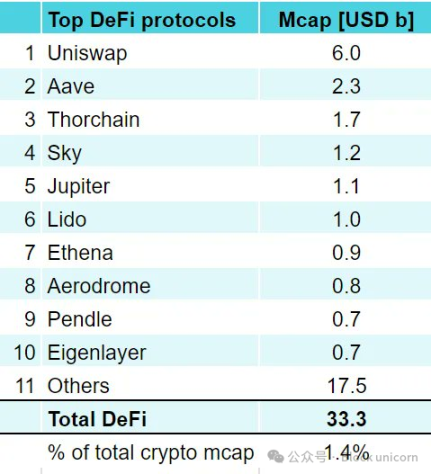
Data as of October 13, 2024
The growth and success of DeFi has been largely overlooked in the near term due to challenging market conditions and industry conditions, however this will change as DeFi protocols continue to grow at an incredible pace and pass along value from this growth to token holders (e.g., Aave’s recently proposed token economics changes).
Market participants will further recognize the fundamentals and potential of DeFi and reallocate their capital accordingly.
We expect DeFi assets to grow from 1.4% to 10% of total crypto market capitalization over the next two years as DeFi continues to grow and the market realizes its newfound appeal and renewed potential.
Make DeFi great again.
This article is sourced from the internet: The Renaissance of Decentralized Finance: Making DeFi Great Again
Related: TVL increased 7 times, data review of TONs DeFi development in the second quarter
Original author: The Open Platform Original translation: 1912212.eth, Foresight News The second quarter of 2024 is a turning point for TONs DeFi ecosystem, with the launch of native USDT, and its liquidity and trading volume have increased significantly. This growth has made the TON/USDT liquidity pool on DeDust and STON.fi the largest stablecoin multi-exposure liquidity pool in the public chain (source DefiLlama data). In addition, TON also launched important infrastructure this quarter. In this report, we will explore the following: Data chart trends; Market dynamics of TON DEX liquidity pools; Small-protocol TVL performance: EVAA and Storm Trade; Launched ION Finance, DEX Diamonads, and Tradoor; The solution to bring EVM functionality to TON: TON Application Chain; Launched decentralized development platform TonFura. The launch of USDT-TON has increased TON’s TVL by 7…







